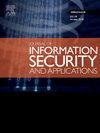Evaluating the Unpredictability of Multi-Bit Strong PUF Classes
IF 3.7
2区 计算机科学
Q2 COMPUTER SCIENCE, INFORMATION SYSTEMS
Journal of Information Security and Applications
Pub Date : 2025-09-23
DOI:10.1016/j.jisa.2025.104234
引用次数: 0
Abstract
With advances in machine learning (ML), cybersecurity solutions and security primitives are becoming increasingly vulnerable to successful attacks. Strong Physical Unclonable Functions (PUFs) emerge as a potential countermeasure that offers high resistance to such attacks. In this paper, we introduce a generalized attack model that leverages the collective responses of multiple PUF chips within the same class to improve the prediction accuracy of responses for unobserved challenges, in contrast to traditional single-chip approaches. Furthermore, we propose an information-theoretic framework for assessing the unpredictability of multi-bit strong PUF classes, demonstrating that the Entropy Rate is a pivotal metric for evaluating their resilience against ML attacks. Our proposed entropy rate estimation serves as a model-agnostic, information-theoretic lower bound on the unpredictability that holds regardless of the attack strategy used, including ML-based ones. We argue that the Uniqueness measure, defined in terms of entropy, provides a more precise and consistent evaluation compared to traditional metrics based on Hamming distance. Additionally, we present a computationally efficient method for calculating the finite-order Entropy Rate of the hybrid Boolean network (HBN) PUF, addressing the challenges posed by high dimensionality. The experimental results validate the high unpredictability and resistance of the HBN PUF class against ML attacks.
评估多位强PUF类的不可预测性
随着机器学习(ML)的进步,网络安全解决方案和安全原语越来越容易受到成功的攻击。强大的物理不可克隆功能(puf)作为一种潜在的对策出现,对此类攻击提供了很高的抵抗力。在本文中,我们引入了一种广义攻击模型,与传统的单芯片方法相比,该模型利用同一类中的多个PUF芯片的集体响应来提高对未观察到的挑战的响应的预测精度。此外,我们提出了一个信息理论框架来评估多比特强PUF类的不可预测性,证明熵率是评估其抗ML攻击弹性的关键指标。我们提出的熵率估计作为不可预测性的模型不可知的信息理论下界,无论使用何种攻击策略(包括基于ml的攻击策略)都适用。我们认为,与基于汉明距离的传统度量相比,以熵定义的唯一性度量提供了更精确和一致的评估。此外,我们提出了一种计算高效的方法来计算混合布尔网络(HBN) PUF的有限阶熵率,解决了高维带来的挑战。实验结果验证了HBN PUF类对ML攻击的高不可预测性和抵抗性。
本文章由计算机程序翻译,如有差异,请以英文原文为准。
求助全文
约1分钟内获得全文
求助全文
来源期刊

Journal of Information Security and Applications
Computer Science-Computer Networks and Communications
CiteScore
10.90
自引率
5.40%
发文量
206
审稿时长
56 days
期刊介绍:
Journal of Information Security and Applications (JISA) focuses on the original research and practice-driven applications with relevance to information security and applications. JISA provides a common linkage between a vibrant scientific and research community and industry professionals by offering a clear view on modern problems and challenges in information security, as well as identifying promising scientific and "best-practice" solutions. JISA issues offer a balance between original research work and innovative industrial approaches by internationally renowned information security experts and researchers.
 求助内容:
求助内容: 应助结果提醒方式:
应助结果提醒方式:


